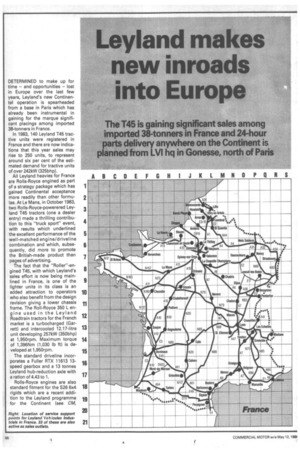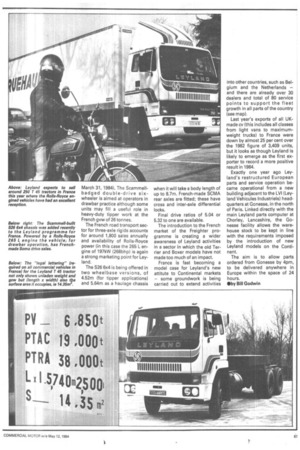Leyland makes new inroads into Europe
Page 68

Page 69

If you've noticed an error in this article please click here to report it so we can fix it.
DETERMINED to make up for time — and opportunities — lost in Europe over the last few years, Leyland's new Continental operation is spearheaded from a base in Paris which has already been instrumental in gaining for the marque significant placings among imported 38-tonners in France.
In 1983, 140 Leyland T45 tractive units were registered in France and there are now indications that this year sales may rise to 250 units, to represent around six per cent of the estimated demand for tractive units of over 242kW (325bhp).
All Leyland heavies for France are Rolls-Royce engined as part of a strategy package which has gained Continental acceptance more readily than other formulae. At Le Mans, in October 1983, two Rolls-Royce-powerered Leyland 145 tractors (one a dealer entry) made a thrilling contribution to this "truck sport" event, with results which underlined the excellent performance of the well-matched engine/driveline combination and which, subsequently, did more to promote the British-made product than pages of advertising.
The fact that the "Roller"-engined T45, with which Leyland's sales effort is now being mainlined in France, is one of the lighter units in its class is an added attraction to operators who also benefit from the design revision giving a lower chassis frame. The Roll-Royce 350 L engine used in the Leyland Roadtrain tractors for the French
market is a turbocharged (Garrett) and intercooled 12.17-litre
unit developing 257kW (350bhp) at 1,950rpm. Maximum torque of 1,396Nm (1,030 lb ft) is developed at 1,950rpm.
The standard driveline incorporates a Fuller RTX 11613 13speed gearbox and a 13 tonnes Leyland hub-reduction axle with a ration of 4.43 to 1.
Rolls-Royce engines are also standard fitment for the S26 6x4 rigids which are a recent addition to the Leyland programme for the Continent (see CM,
March 31, 1984). The Scammellbadged double-drive sixwheeler is aimed at operators in drawbar practice although some units may fill a useful role in heavy-duty tipper work at the French gvw of 26 tonnes.
The French road transport sector for three-axle rig ids accounts for around 1,800 sales annually and availability of Rolls-Royce power (in this case the 265 L engine of 197kW (268bhp) is again a strong marketing point for Leyland.
The 526 6x4 is being offered in two wheelbase versions, of 4.52m (for tipper applications) and 5.64m as a haulage chassis when it will take a body length of up to 8.7m. French-made SCMA rear axles are fitted; these have cross and inter-axle differential locks.
Final drive ratios of 5.04 or 5.32 to one are available.
The introduction to the French market of the Freighter programme is creating a wider awareness of Leyland activities in a sector in which the old Terrier and Boxer models have not made too much of an impact.
France is fast becoming a model case for Leyland's new attitute to Continental markets — some groundwork is being carried out to extend activities into other countries, such as Belgium and the Netherlands — and there are already over 30 dealers and total of 80 service points to support the fleet growth in all parts of the country (see map).
Last year's exports of all UKmade cv (this includes all classes from light vans to maximumweight trucks) to France were down by almost 25 per cent over the 1982 figure of 3,409 units, but it looks as though Leyland is likely to emerge as the first exporter to record a more positive result in 1984.
Exactly one year ago Leyland's restructured European parts and service operation became operational from a new building adjacent to the LVI (Leyland Vehicules Industriels) headquarters at Gonesse, in the north of Paris. Linked directly with the main Leyland parts computer at Chorley, Lancashire, the Gonesse facility allows the warehouse stock to be kept in line with the requirements imposed by the introduction of new • Leyland models on the Continent.
The aim is to allow parts ordered from Gonesse by 4pm, to be delivered anywhere in Europe within the space of 24 hours.
Oby Bill Godwin












































































































